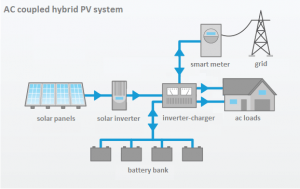AC coupled solar PV systems with Battery Storage
In an AC coupled system the PV array is connected directly to a solar inverter. The inverter converts the direct current (DC) supplied by the array to alternating current (AC). This is then supplied to the loads on site. For an on-grid system, the solar inverter is further connected to the electricity network via a smart meter. This allows the solar system to export power to the grid when it produces more than is required on site. The meter keeps track of the net usage of power from the grid allowing savings in energy costs based on the power generated by the PV system.
The majority of solar installations in Australia are connected in the AC coupled arrangement. In comparison to other possible PV system configurations, this is an efficient way to supply power to a site where the majority of loads require AC power. It also allows for maximum flexibility in system design, keeping installation and balance of system (BOS) component costs to a minimum.
If battery storage is included in a grid tied solar PV system, this is known as a hybrid configuration. This is because such a system has elements of both an off-grid and an on-grid PV system. A hybrid solar system can utilise either a single hybrid inverter or, in the case of a retrofit installation, an inverter-charger in addition to the existing solar inverter. The inverter-charger is employed to charge and discharge the battery storage bank.
When retrofitting battery storage to a PV system, DC coupled systems almost always entail extra cost and installation time over AC coupled systems. This is because, as mentioned in the previous section, most solar installations in Australia are already configured as AC coupled systems. The Tesla Powerwall uses a DC coupled configuration to provide the battery storage capability and is currently impractical for most retrofit installations in Australia.


